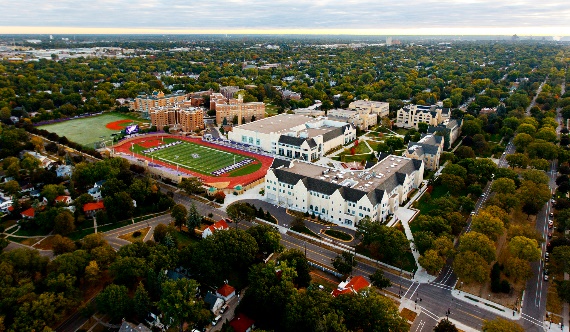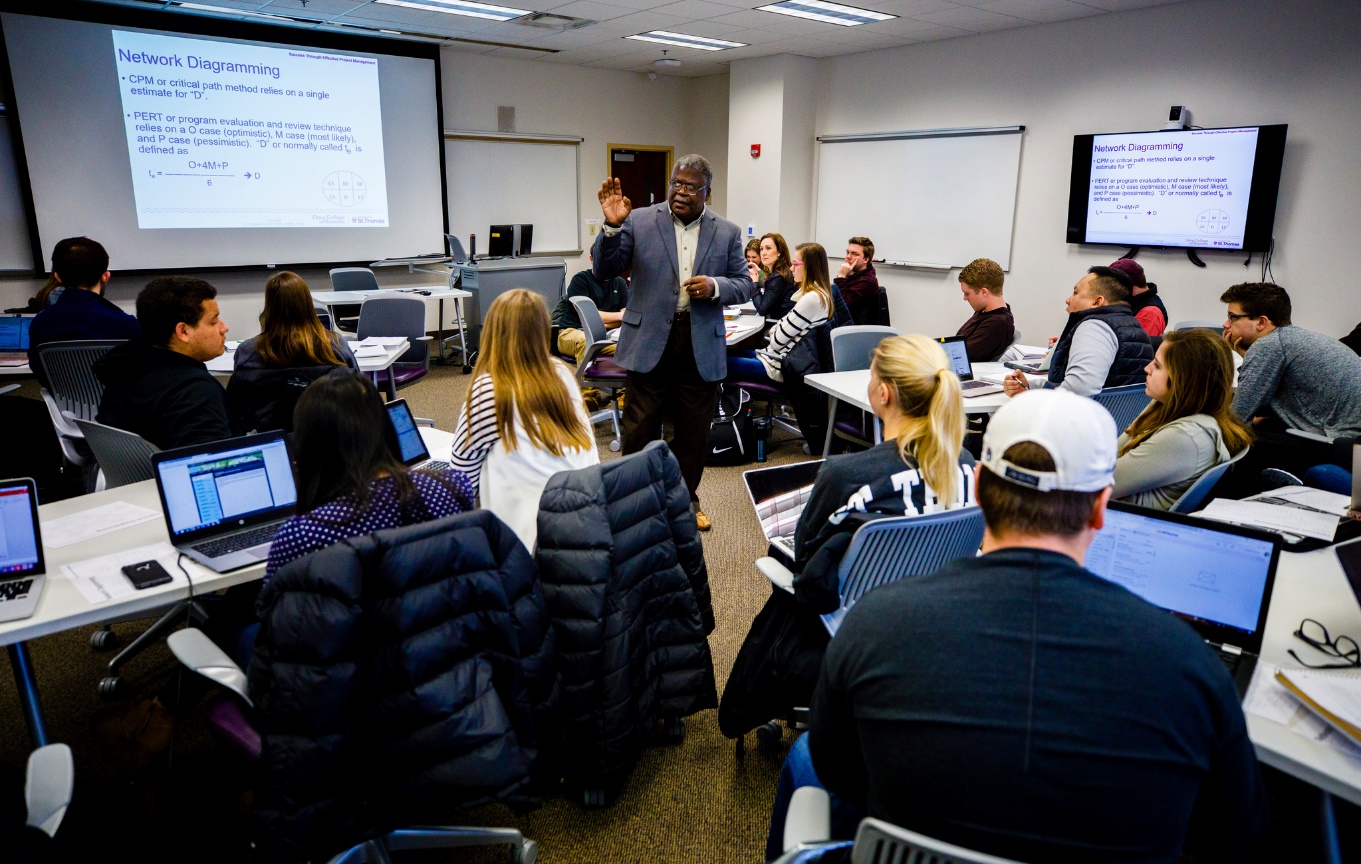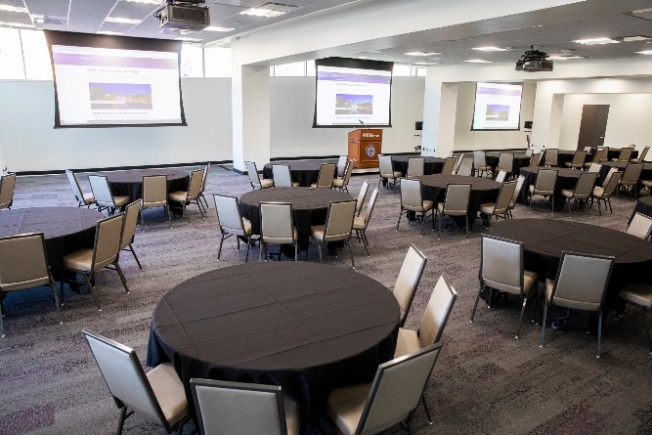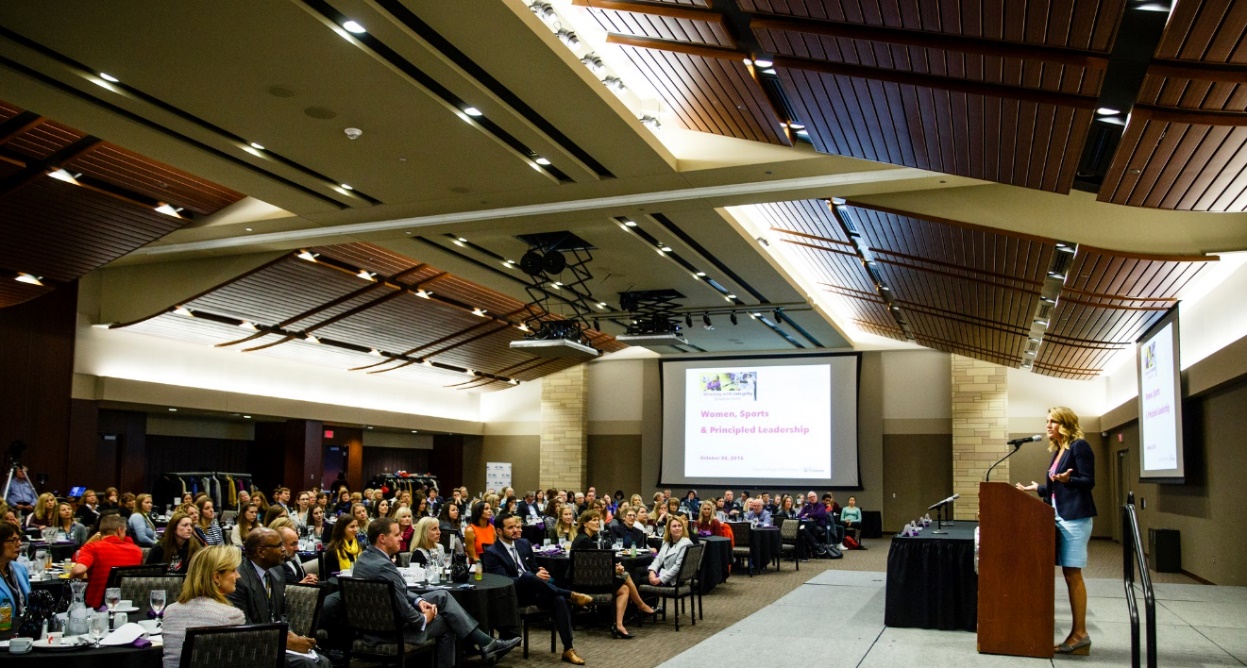February 13, 2023
6 min read
Challenge
As the largest private university in Minnesota, the University of St. Thomas offers more than 9,000 students over 150 undergraduate majors and minors and over 55 graduate degree programs. While the majority of their courses take place in person, both graduate and undergraduate programs must also support a hybrid model. Maintaining both in-person and virtual learning for such a large student population means the university must have the right technology deployed in every classroom. In 2021, as Patrick Eisenhauer came on board as Director of Audiovisual & Event Services, the university realized it needed to upgrade its projection and display technology across campus. Many of the outdated projectors had not been replaced in the past because upgrading them would have required a significant investment in time and resources to update the code of the control systems, which were designed for models from different manufacturers. In addition, the team sought the cost savings that come with a transition from lamp-based projectors to laser models. As the university continued its ongoing process of replacing legacy systems, the audiovisual team needed to ensure these new models would work with current and future set-ups.
Solution
After embarking on an extensive search process, the university’s audiovisual team moved forward with Panasonic Connect because of the features, price point, and product availability. The team chose a range of laser projector models from portable to large-venue projectors, as well as 4K professional displays. In total, the university has deployed over 200 new projectors and 100 new displays in the past two years. These solutions support different spaces across campus from classrooms and meeting rooms to auditoriums and large event spaces. The projectors’ emulation feature was especially important to the university. This offering allows the projectors to receive commands from a control system programmed for a different brand of projectors and translate it to the correct command for the Panasonic Connect models. This way, the university could take advantage of the new projector models without having to simultaneously upgrade the control systems. Using their existing code saved the audiovisual team hours of coding and streamlined operations. For specific rooms that posed a challenge, the audiovisual team worked with Panasonic Connect’s engineers to develop a custom emulation code.
Result
In classrooms across campus, professors use the projectors to show media and visual presentations, while displays help reinforce lessons and showcase student work in active learning rooms. The new AV solutions also support visual presentations in event spaces used by both internal and external parties, such as visuals for weddings held at the campus’ chapel and reception rooms. The displays have been particularly useful for the athletics department as they are used in offices, meeting rooms and locker rooms to review game footage. Faculty have appreciated the upgrade to laser projector models, commenting on the consistent brightness and better performance. By the summer of 2023, the university hopes to convert all of its projectors and displays to Panasonic Connect models. The audiovisual team is also working with Panasonic Connect as they embark on the process of deploying new, enhanced video conferencing platforms.
+++
From finding the right solution to coordinating an efficient deployment process, upgrading AV equipment across an entire university campus is challenging. In 2021, the University of St. Thomas found itself embarking on this process at a large scale, seeking out nearly 200 new projectors and close to 100 new displays.
As the largest private university in Minnesota, the University of St. Thomas houses eight schools and colleges offering more than 150 undergraduate majors and minors and more than 55 graduate degree programs for over 9,000 students. While the majority of their courses take place in person, both graduate and undergraduate programs must also support a hybrid model.
In order to provide optimal learning experiences for both remote and in person settings, the university needed to deploy the right technology in every classroom. In 2021, Patrick Eisenhauer joined the university as Director of Audiovisual and Event Services, and he and his team wanted to make the switch from lamp-based projectors to laser models that would deliver better cost savings. Many of the outdated projectors had not been replaced in the past because upgrading them would have taken significant time and resources to update the code of the control systems, which were designed for models from different manufacturers. Patrick and his team needed a solution that would make upgrading these projector models more efficient.
The audiovisual team needed to make sure the projectors would support a range of different connection modes as they upgrade legacy systems across campus. The university prefers DIGITAL LINK connections, and this is one of the key features the team sought in a projector. The university also needed to upgrade their digital displays, so faculty and presenters could use them to showcase extra visuals alongside projected content.
Ultimately, the university needed to find projector and display solutions that could deliver the cost savings they sought and support their current systems and future upgrades. They also needed a partner who could help ensure an efficient deployment process to minimize disruption to the learning process.
The audiovisual team queried several vendors for solutions. Panasonic Connect differentiated itself. Features and price point were important to the university, but product availability was also a key selling point. “Panasonic Connect was able to get us 200 projectors in 2-3 months, which is no small feat,” says Patrick. “The relationship we developed with our salesperson from Panasonic Connect has been a major benefit to the university. From the start, he was responsive and helpful.”
Overall, the University of St. Thomas deployed the:
- PT-VMZ50U Portable Laser Projector in classrooms and meeting room spaces
- PT-MZ10KU 3LCD SOLID SHINE Laser Projector in auditoriums and event spaces
- PT-MZ13KU 3LCD SOLID SHINE Laser Projector in a divisible events space
- PT-MZ16KU 3LCD SOLID SHINE Laser Projector in an auditorium
- PT-RZ12KU 3-Chip DLP™ Laser Projector in their largest divisible events space
- TH-49CQE1 4K Professional Display in classrooms as mobile secondary displays and for digital signage around campus
- Various sizes (55”, 65”, 75” and 86”) of the TH-CQE1 Series Professional Displays in classrooms and meeting rooms across campus
While color accuracy, size and lumens were all important factors in choosing the projectors, emulation was a key deciding feature for the university. This feature allows Panasonic Connect projectors to receive a command from a control system designed for a different projector brand without having to change the required code. That way, the audiovisual team could use the new Panasonic Connect projectors alongside older AV control systems they weren’t ready to replace yet. Adopting this approach saved the university many coding hours and simplified overall operations, as each classroom could have the same code.
“We set up the new projectors and worried about emulation later,” explains Patrick. “When we had programming challenges, we went to Panasonic Connect’s engineers and they wrote a custom code for us. This solved all of our problems.” Ultimately, the university could enjoy the benefits of the new Panasonic Connect projectors without having to update all of the AV control systems as well.
The projectors and displays are used for a variety of different applications across campus. In classrooms, professors use projectors for visual presentations alongside their lectures and to show other media, such as film and video. Displays serve as an additional visual tool to reinforce lessons in active learning rooms. In event spaces, the solutions support concerts and academic conferences, in addition to external events for parties that choose to rent the space, such as weddings. The solutions also appear in meeting rooms and the athletics department finds the displays particularly useful for reviewing game footage and conducting presentations.
Faculty noticed the difference of the laser projectors. They witness consistent brightness with no dimming and overall better performance without having to worry about the lamps blowing out and disrupting the learning process.
Patrick and his team aim to expand their partnership with Panasonic Connect and continue upgrading the campus’s AV tech. “I don’t always have time to read up on different specs and research different solution models,” explains Patrick. “It’s great that I can call up our partners at Panasonic Connect, ask for their opinion on what to purchase, and then get a loaner unit to try right away. It really streamlines the entire process.”
By the summer of 2023, the university hopes to convert all of their projectors and displays to Panasonic Connect models. The audiovisual team is also currently re-evaluating all of their cameras and is looking within the Panasonic Connect family. Their goal is to have base level video conferencing (camera and microphone) available in every classroom. As the university expands on its mission to support interactive and engaging learning environments, the audiovisual team is also working to outfit the Schoenecker Center building with Panasonic Connect projectors and displays. This facility, slated for 2024 completion, will feature standard classrooms and labs for science, technology, engineering, arts and math, in addition to rehearsal and performance spaces for the music department.



